Applicability of Machine-Learned Regression Models to Estimate Internal Air Temperature and CO2 Concentration of a Pig House
Abstract
1. Introduction
2. Materials and Methods
2.1. Training Data (Experimental Pig House and Breeding Conditions)
2.2. Machine Learning Model
2.2.1. ElasticNet
2.2.2. Support Vector Regression (SVR)
2.2.3. Random Forest
2.3. Data Pre-Processing and Training
2.4. Predictive Model Validation and Selection
3. Results and Discussion
3.1. Field-Measured Experimental Pig House Data
3.2. Selection of Machine Learning (ML) Model Features
3.3. Evaluation of Predictive Models
3.4. Model Evaluation by Hyperparameter Tuning
4. Conclusions
Author Contributions
Funding
Acknowledgments
Conflicts of Interest
References
- Madden, R.A.; Ramanathan, V. Detecting Climate Change due to Increasing Carbon Dioxide. Science 1980, 209, 763–768. [Google Scholar] [CrossRef]
- Cao, L.; Bala, G.; Caldeira, K.; Nemani, R.; Ban-Weiss, G. Importance of carbon dioxide physiological forcing to future climate change. Proc. Natl. Acad. Sci. USA 2010, 107, 9513–9518. [Google Scholar] [CrossRef] [PubMed]
- Kellogg, W.W.; Schware, R. Climate Change and Society: Consequences of Increasing Atmospheric Carbon Dioxide; Routlege: Abingdon, UK, 1981. [Google Scholar] [CrossRef]
- United Nations (UN). 5 Things You Should Know about the Greenhouse Gases warming the Planet. un.org. Available online: https://news.un.org/en/story/2022/01/1109322 (accessed on 2 June 2022).
- Salvia, M.; Reckien, D.; Pietrapertosa, F.; Eckersley, P.; Spyridaki, N.-A.; Krook-Riekkola, A.; Olazabal, M.; De Gregorio Hurtado, S.; Simoes, S.G.; Geneletti, D.; et al. Will climate mitigation ambitions lead to carbon neutrality? An analysis of the local-level plans of 327 cities in the EU. Renew. Sustain. Energy Rev. 2021, 135, 110253. [Google Scholar] [CrossRef]
- U.S. Energy Information Administration (EIA). International Energy Outlook 2021. Eia.gov. Available online: https://www.eia.gov/outlooks/ieo/ (accessed on 4 September 2018).
- Ministry of Environment (ME). 2021 National Greenhouse Gas Inventory Report of Korea. ME.go.kr. Available online: https://www.keep.go.kr/portal/ (accessed on 2 June 2022).
- Jeong, H.K.; Kim, C.G. Greenhouse Gas Reduction Goals and Response Strategies in the Agricultural Sector; Korea Rural Economic Institute: Naju, Republic of Korea, 2022. [Google Scholar]
- Becattini, V.; Gabrielli, P.; Mazzotti, M. Role of carbon capture, storage, and utilisation to enable a net-zero-CO2-emissions aviation sector. Ind. Eng. Chem. Res. 2021, 60, 6848–6862. [Google Scholar] [CrossRef]
- Ministry of Agriculture, Food and Rural Affairs (MAFRA). Agricultural Production and Production Index in 2020. mafra.go.kr. Available online: https://www.mafra.go.kr/bbs/mafra/65/328585/artclView.do (accessed on 22 April 2022).
- Zong, C.; Li, H.; Zhang, G. Ammonia and greenhouse gas emissions from fattening pig house with two types of partial pit ventilation systems. Agric. Ecosyst. Environ. 2015, 208, 94–105. [Google Scholar] [CrossRef]
- Vermeer, H.M.; Hopster, H. Operationalising principle-based standards for animal welfare—Indicators for climate problems in pig houses. Animals 2018, 8, 44. [Google Scholar] [CrossRef]
- Blanes, V.; Pedersen, S. Ventilation Flow in Pig Houses measured and calculated by Carbon Dioxide, Moisture and Heat Balance Equations. Biosyst. Eng. 2005, 92, 483–493. [Google Scholar] [CrossRef]
- Lee, S.H.; Cho, H.K.; Choi, K.J.; Oh, K.Y.; Yu, B.K.; Lee, I.B.; Kim, K.W. Measurement of ammonia emission rate and environmental parameters from growing-finishing and farrowing house during hot season. J. Anim. Environ. Sci. 2005, 11, 1–10. [Google Scholar]
- Van Buggenhout, S.; Van Brecht, A.; Özcan, S.E.; Vranken, E.; Van Malcot, W.; Berckmans, D. Influence of sampling positions on accuracy of tracer gas measurements in ventilated spaces. Biosyst. Eng. 2009, 104, 216–223. [Google Scholar] [CrossRef]
- Yeo, U.-H.; Jo, Y.-S.; Kwon, K.-S.; Ha, T.-H.; Park, S.-J.; Kim, R.-W.; Lee, S.-Y.; Lee, S.-N.; Lee, I.-B.; Seo, I.-H. Analysis on Ventilation Efficiency of Standard Duck House using Computational Fluid Dynamics. J. Korean Soc. Agric. Eng. 2015, 57, 51–60. [Google Scholar] [CrossRef]
- Oh, B.W.; Lee, S.W.; Kim, H.C.; Seo, I.H. Analysis of working environment and ventilation efficiency in pig house using computational fluid dynamics. J. Korean Soc. Agric. Eng. 2019, 61, 85–95. [Google Scholar]
- Ni, J.-Q.; Vinckier, C.; Hendriks, J.; Coenegrachts, J. Production of carbon dioxide in a fattening pig house under field conditions. II. Release from the manure. Atmos. Environ. 1999, 33, 3697–3703. [Google Scholar] [CrossRef]
- Zong, C.; Zhang, G.; Feng, Y.; Ni, J.-Q. Carbon dioxide production from a fattening pig building with partial pit ventilation system. Biosyst. Eng. 2014, 126, 56–68. [Google Scholar] [CrossRef]
- Arulmozhi, E.; Basak, J.; Sihalath, T.; Park, J.; Kim, H.; Moon, B. Machine Learning-Based Microclimate Model for Indoor Air Temperature and Relative Humidity Prediction in a Swine Building. Animals 2021, 11, 222. [Google Scholar] [CrossRef]
- Yoo, J.; Chung, S.W.; Park, H.S. Applications of Machine Learning Models for the Estimation of Reservoir CO 2 Emissions. J. Korean Soc. Water Environ. 2017, 33, 326–333. [Google Scholar]
- Zou, H.; Hastie, T. Regularization and variable selection via the elastic net. J. R. Stat. Soc. Ser. B (Stat. Methodol.) 2005, 67, 301–320. [Google Scholar] [CrossRef]
- Müller, K.R.; Smola, A.J.; Rätsch, G.; Schölkopf, B.; Kohlmorgen, J.; Vapnik, V. Predicting time series with support vector machines. In International Conference on Artificial Neural Networks; Springer: Berlin/Heidelberg, Germany, 1997; pp. 999–1004. [Google Scholar]
- Dittman, D.J.; Khoshgoftaar, T.M.; Napolitano, A. The Effect of Data Sampling When Using Random Forest on Imbalanced Bioinformatics Data. In Proceedings of the 2015 IEEE International Conference on Information Reuse and Integration, San Francisco, CA, USA, 13–15 August 2015; pp. 457–463. [Google Scholar] [CrossRef]
- Jovanović, R.Ž.; Sretenović, A.A.; Živković, B.D. Ensemble of various neural networks for prediction of heating energy consumption. Energy Build. 2015, 94, 189–199. [Google Scholar] [CrossRef]
- AI Shalabi, L.; Shaaban, Z.; Kasasbeh, B. Data Mining: A Preprocessing Engine. J. Comput. Sci. 2006, 2, 735–739. [Google Scholar] [CrossRef]
- He, Y.; Tiezzi, F.; Howard, J.; Maltecca, C. Predicting body weight in growing pigs from feeding behavior data using machine learning algorithms. Comput. Electron. Agric. 2021, 184, 106085. [Google Scholar] [CrossRef]
- Valente, J.M.; Maldonado, S. SVR-FFS: A novel forward feature selection approach for high-frequency time series forecasting using support vector regression. Expert Syst. Appl. 2020, 160, 113729. [Google Scholar] [CrossRef]
- MWPS. Swine Housing and Equipment Handbook; MWPS-8; Midwest Plan Service; Iowa State University: Ames, IA, USA, 1988. [Google Scholar]
- Schnier, S.; Middendorf, L.; Janssen, H.; Brüning, C.; Rohn, K.; Visscher, C. Immunocrit serum amino acide concentrations and growth performance in light and heavy piglets depending on sow’s farrowing systems. Porc. Health Manag. 2019, 5, 1–12. [Google Scholar] [CrossRef] [PubMed]
- Kim, K.Y.; Seo, S.C.; Choi, J.-H. Effect of General Ventilation Rate on Concentrations of Gaseous Pollutants Emitted from Enclosed Pig Building. J. Korean Soc. Occup. Environ. Hyg. 2014, 24, 46–51. [Google Scholar] [CrossRef]
- Kim, D.; Lee, I.B.; Yeo, U.H.; Lee, S.Y.; Park, S.; Decano, C.; Kim, J.-g.; Choi, Y.b.; Cho, J.-b.; Jeong, H.-h.; et al. Estimation of duck house litter evaporation rate using machine learning. J. Korean Soc. Agric. Eng. 2021, 63, 77–88. [Google Scholar]
- Schibuola, L.; Scarpa, M.; Tambani, C. CO2 based ventilation control in energy retrofit: An experimental assessment. Energy 2018, 143, 606–614. [Google Scholar] [CrossRef]
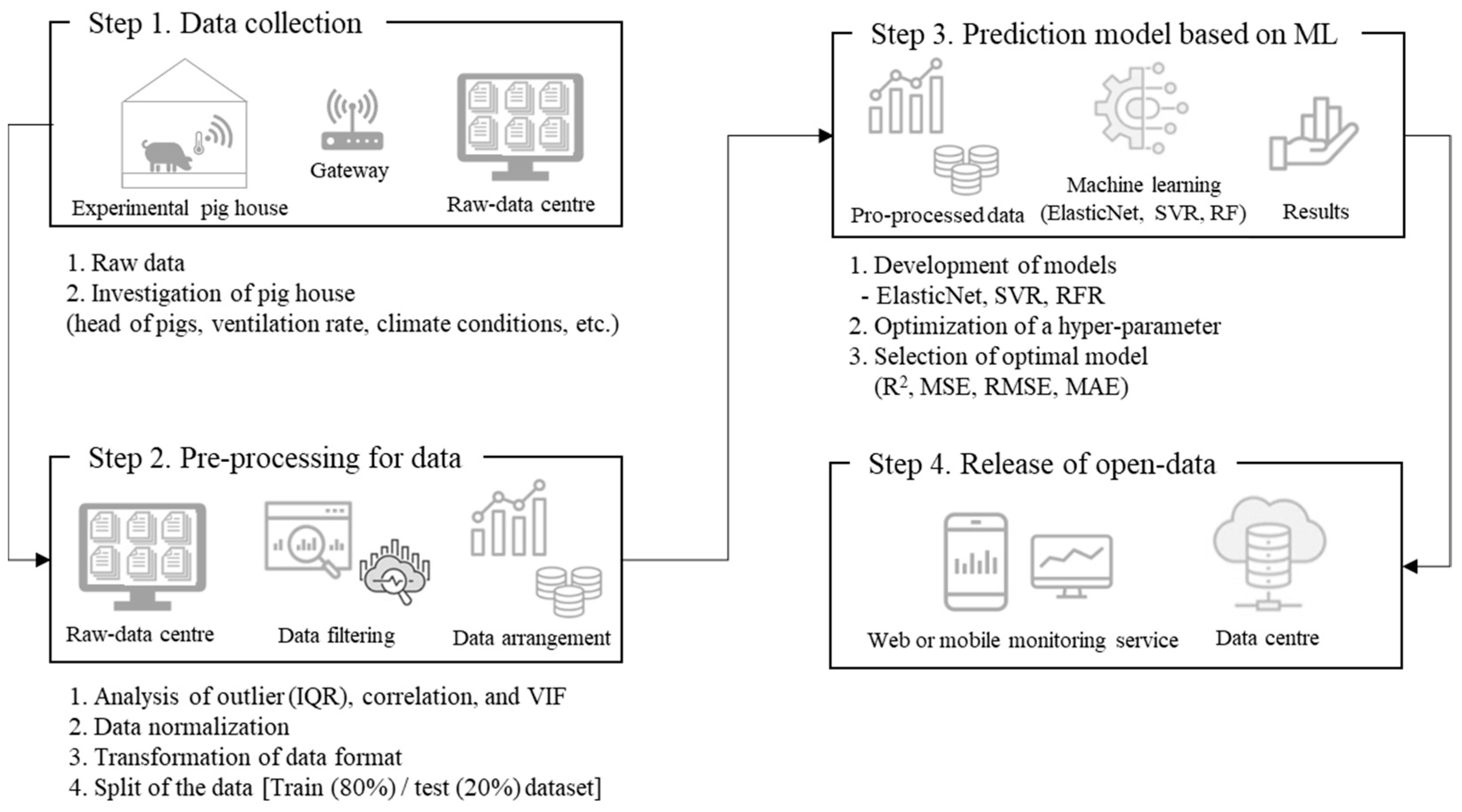
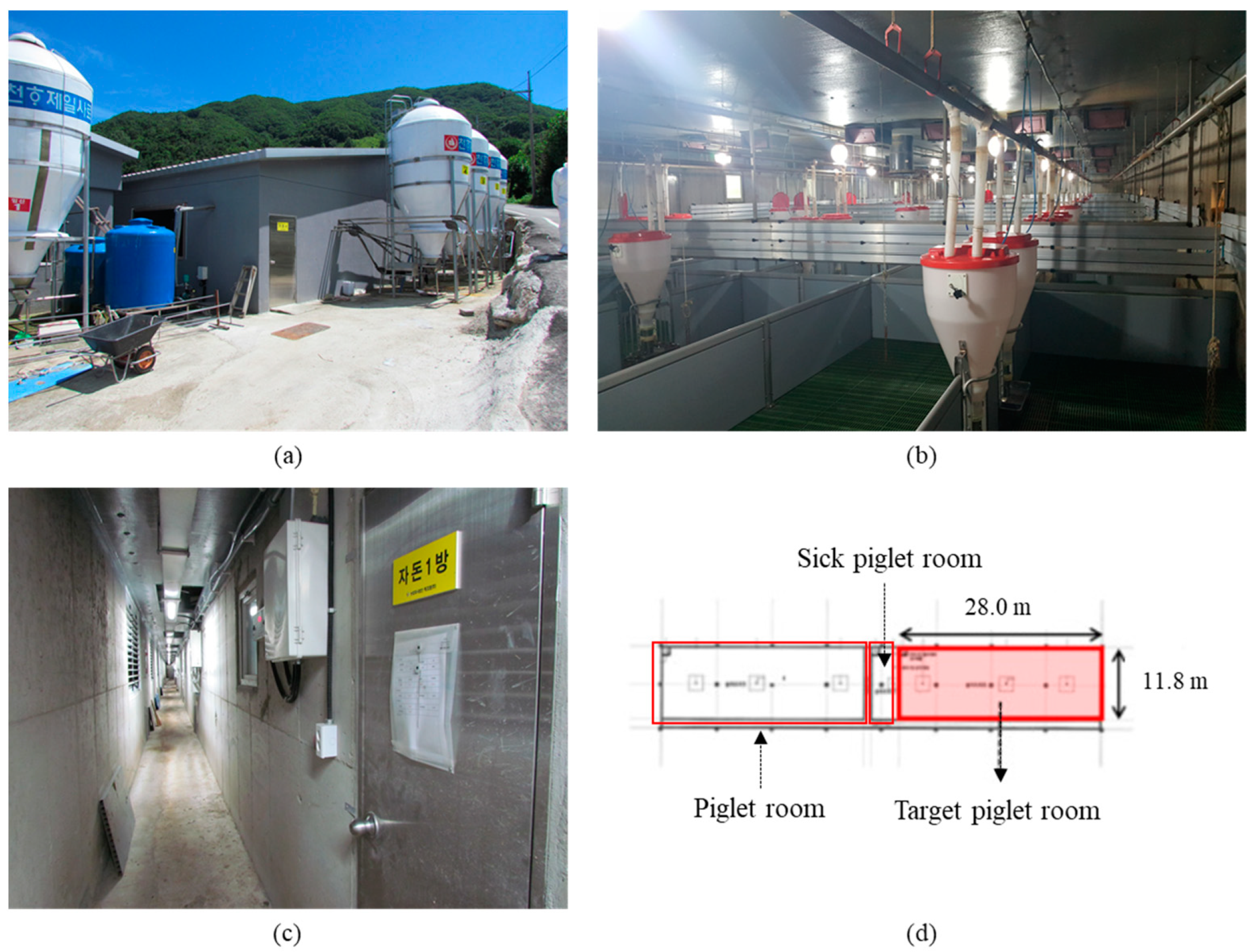


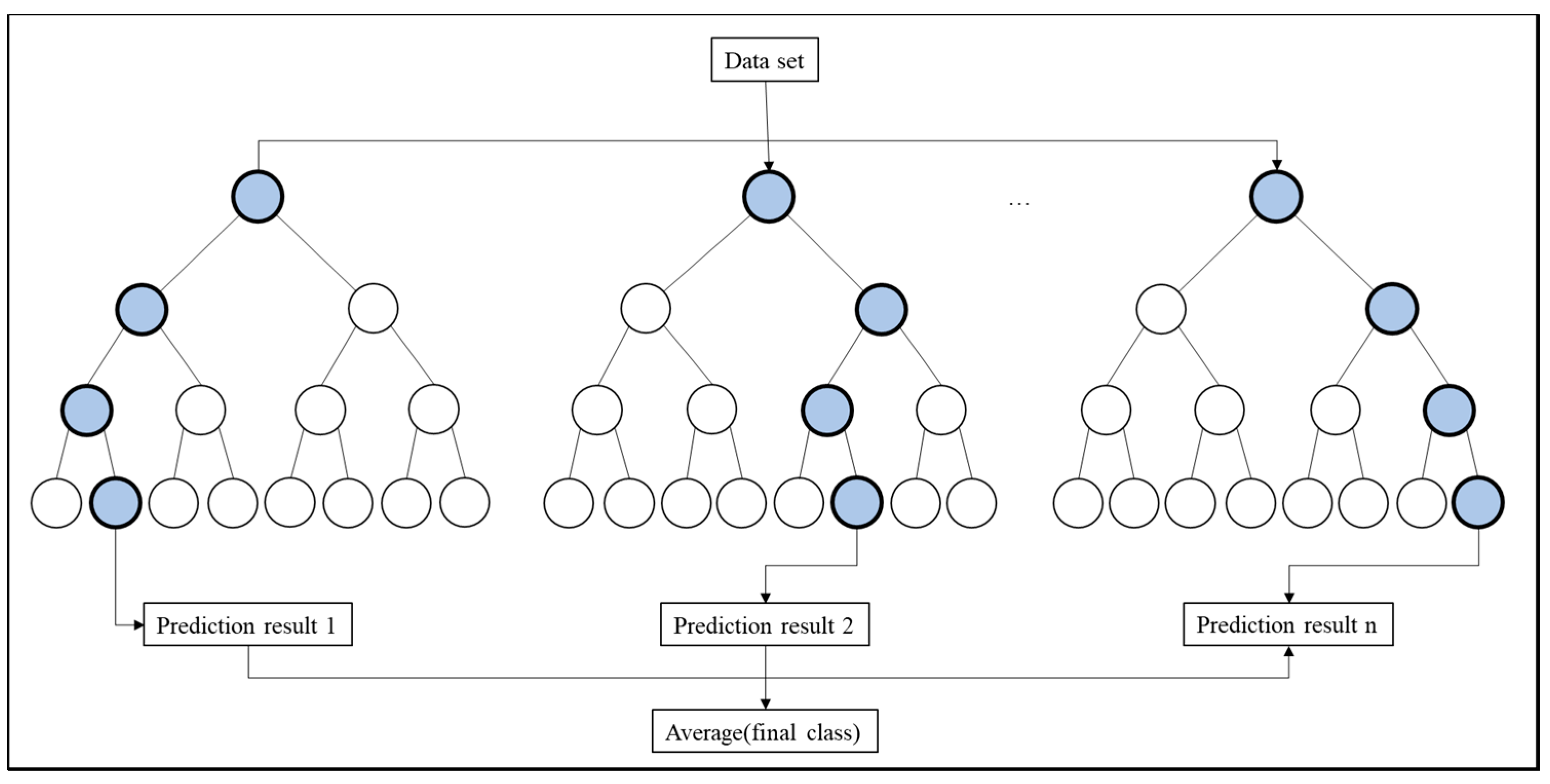
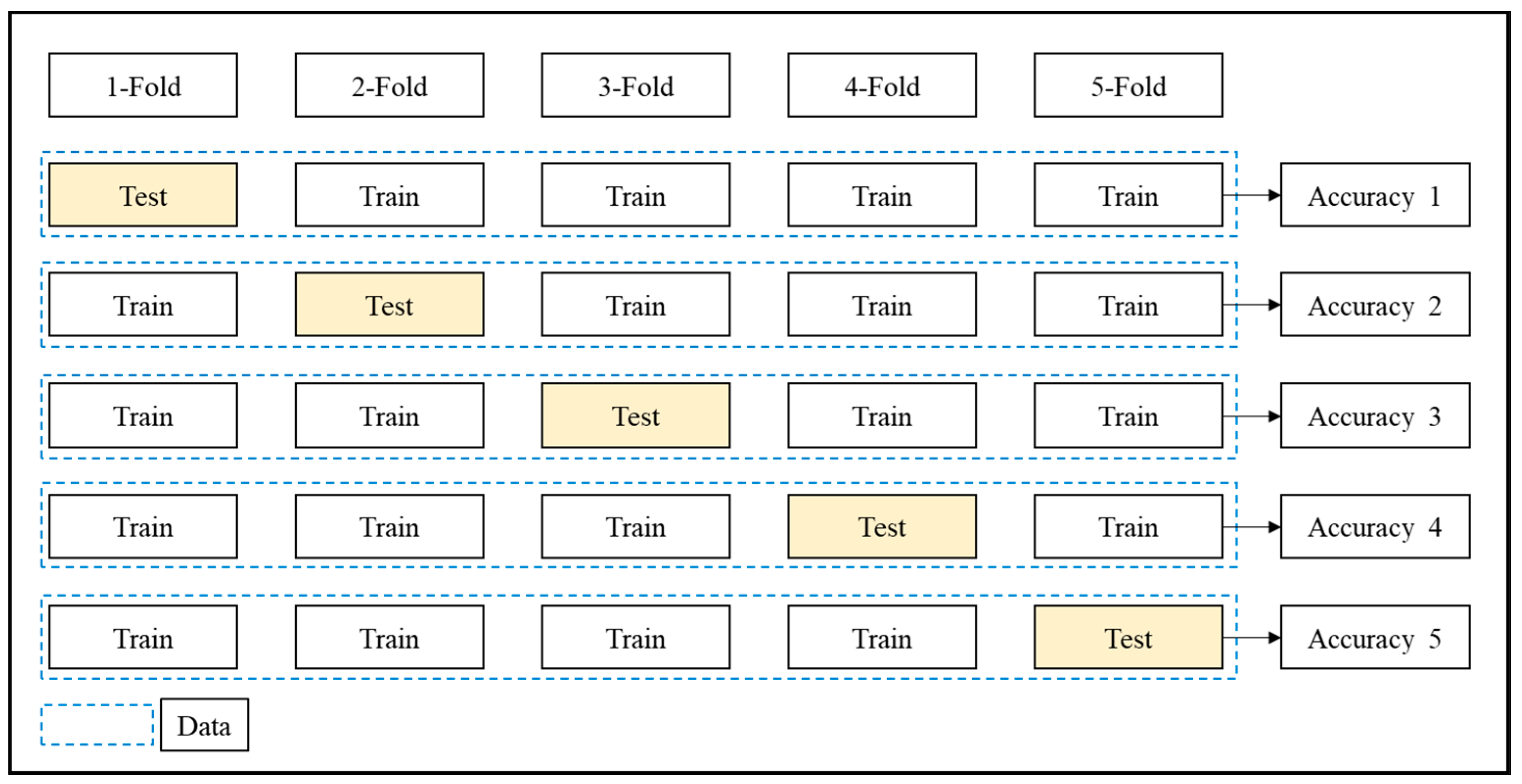
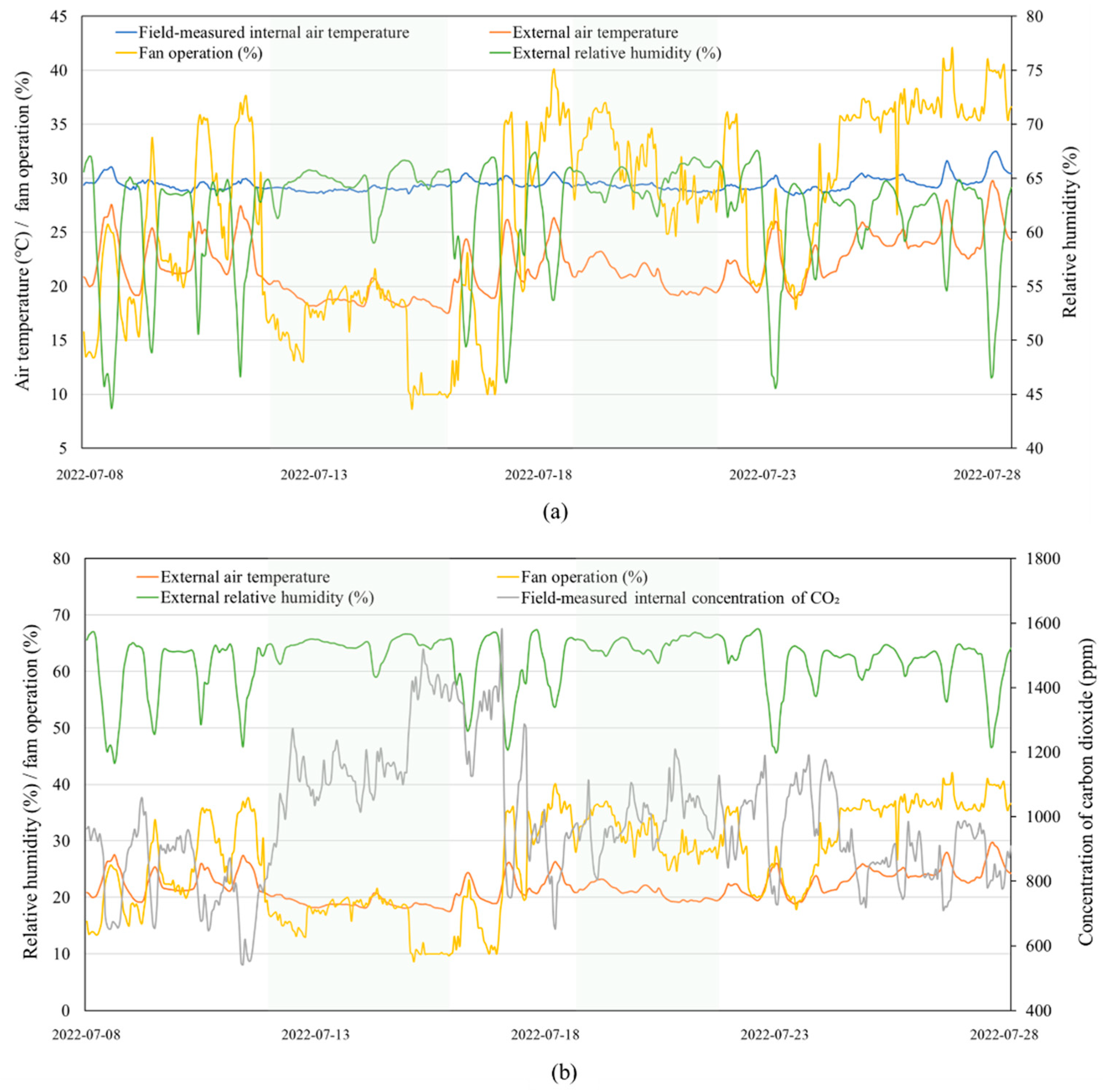
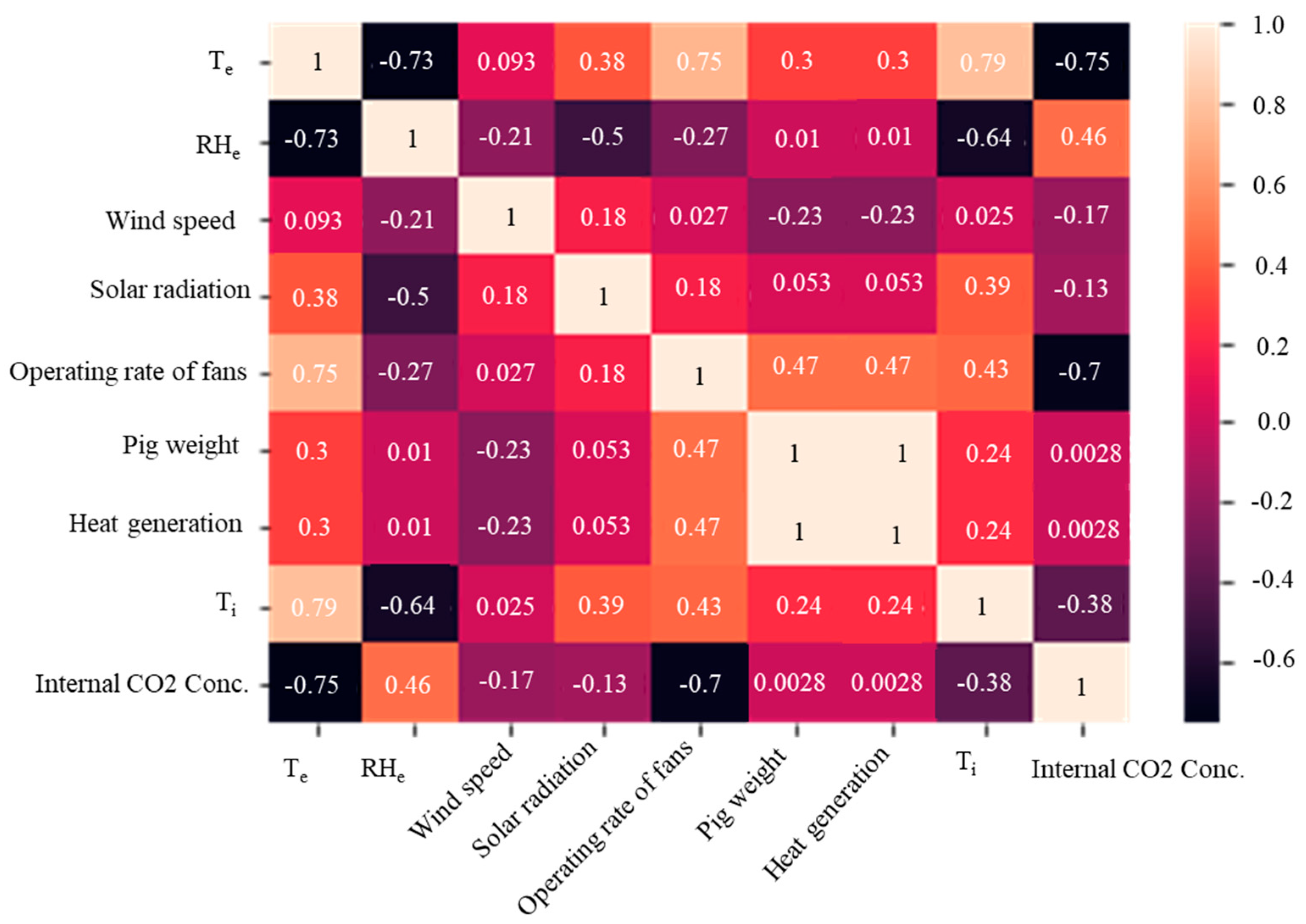
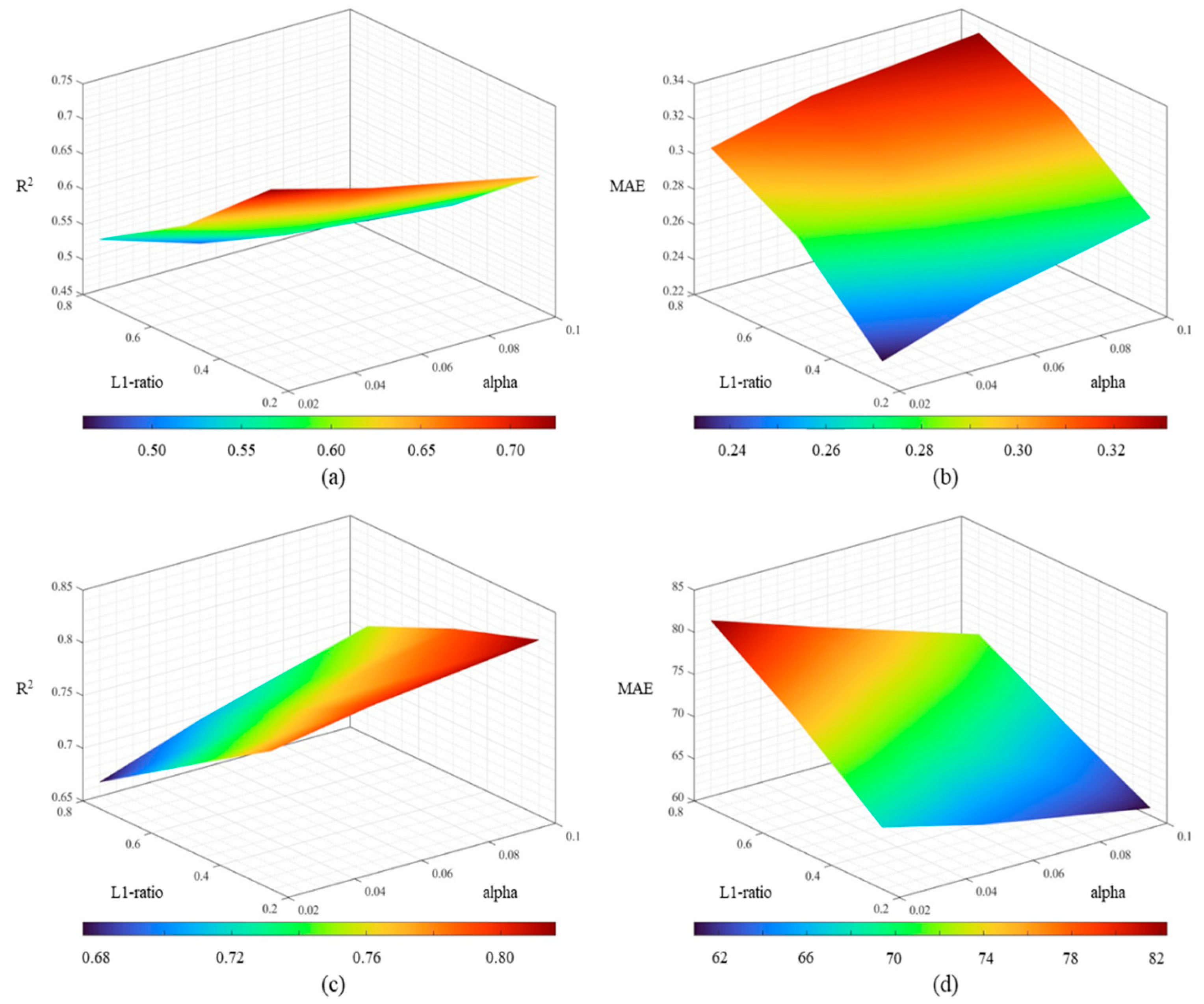
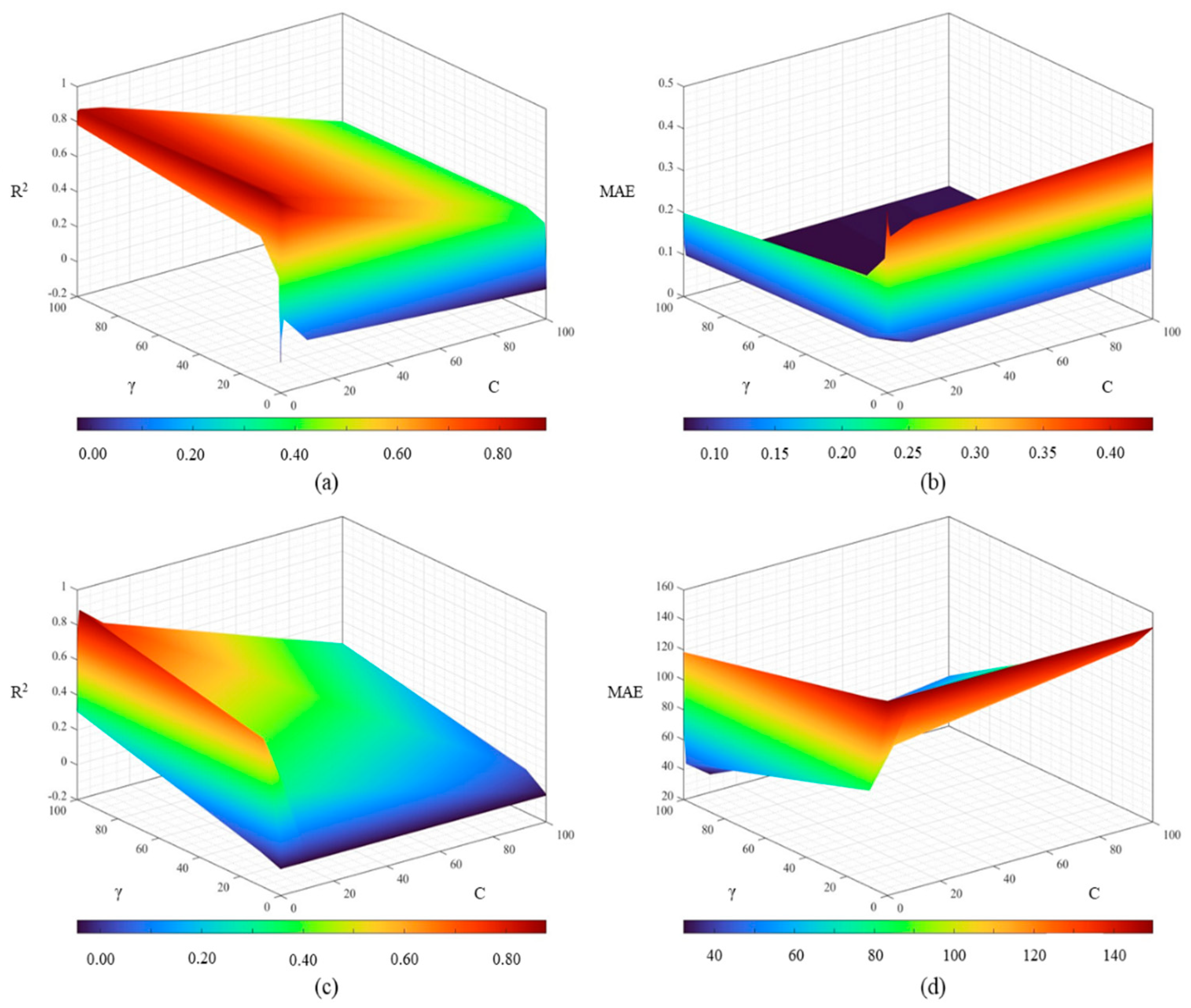
| Pig House Type | Mechanically Ventilated Pig House | Floor Area and Volume | 330.4 m2 1387.7 m3 | |
| Floor type | Partially concreted | Number of exhaust fans | Roof | 4 |
| Sidewall | 6 | |||
| Number of piglet growth days | 50–90 | Fan size and performance | Roof | D500/8500CMH (418 W) |
| Sidewall | D500/8500CMH (535 W) | |||
| Cleaning pig house and pit | Before bringing in new piglets | Set ventilation controller air temperature | 28 °C | |
| Algorithm | Hyperparameter | Defined Values |
|---|---|---|
| ElasticNet | α | 0.02, 0.05, and 0.1 |
| L1 ratio | 0.25, 0.5, and 0.75 | |
| SVR | C | 0.01, 0.1, 1, 10, and 100 |
| γ | 0.01, 0.1, 1, 10, and 100 | |
| RF | n-estimator | 1, 10, 50, and 100 |
| Dataset | Statistical Index | ElasticNet (a: 0.02; L1-Ratio: 0.25) | SVR (C:10 and γ: 1) | RFR (n-Estimator: 100) |
|---|---|---|---|---|
| Training | RMSE | 0.228 | 0.084 | 0.152 |
| MAE | 0.167 | 0.060 | 0.063 | |
| R2 | 0.867 | 0.983 | 0.940 | |
| Test | RMSE | 0.251 | 0.221 | 0.201 |
| MAE | 0.178 | 0.151 | 0.141 | |
| R2 | 0.835 | 0.865 | 0.891 |
| Dataset | Statistical Index | ElasticNet (a: 0.02; L1-Ratio: 0.75) | SVR (C:100 and γ: 1) | RFR (n-Estimator: 50) |
|---|---|---|---|---|
| Training | RMSE | 73.871 | 61.189 | 22.175 |
| MAE | 57.995 | 43.668 | 15.632 | |
| R2 | 0.853 | 0.899 | 0.987 | |
| Test | RMSE | 79.702 | 66.415 | 59.468 |
| MAE | 62.284 | 50.422 | 42.756 | |
| R2 | 0.825 | 0.880 | 0.900 |
| Dataset | Statistical Index | 1 | 10 | 50 | 100 |
|---|---|---|---|---|---|
| Training | RMSE | 0.184 | 0.1 | 0.265 | 0.265 |
| MAE | 0.075 | 0.063 | 0.056 | 0.055 | |
| R2 | 0.910 | 0.974 | 0.982 | 0.983 | |
| Test | RMSE | 0.315 | 0.235 | 0.226 | 0.221 |
| MAE | 0.204 | 0.160 | 0.152 | 0.151 | |
| R2 | 0.730 | 0.848 | 0.859 | 0.865 |
| Dataset | Statistical Index | 1 | 10 | 50 | 100 |
|---|---|---|---|---|---|
| Training | RMSE | 61.013 | 26.978 | 22.175 | 23.458 |
| MAE | 24.762 | 17.998 | 15.632 | 15.848 | |
| R2 | 0.899 | 0.980 | 0.987 | 0.987 | |
| Test | RMSE | 99.966 | 64.392 | 59.468 | 61.046 |
| MAE | 63.707 | 46.173 | 42.726 | 43.478 | |
| R2 | 0.728 | 0.885 | 0.902 | 0.897 |
Disclaimer/Publisher’s Note: The statements, opinions and data contained in all publications are solely those of the individual author(s) and contributor(s) and not of MDPI and/or the editor(s). MDPI and/or the editor(s) disclaim responsibility for any injury to people or property resulting from any ideas, methods, instructions or products referred to in the content. |
© 2023 by the authors. Licensee MDPI, Basel, Switzerland. This article is an open access article distributed under the terms and conditions of the Creative Commons Attribution (CC BY) license (https://creativecommons.org/licenses/by/4.0/).
Share and Cite
Yeo, U.-H.; Jo, S.-K.; Kim, S.-H.; Park, D.-H.; Jeong, D.-Y.; Park, S.-J.; Shin, H.; Kim, R.-W. Applicability of Machine-Learned Regression Models to Estimate Internal Air Temperature and CO2 Concentration of a Pig House. Agronomy 2023, 13, 328. https://doi.org/10.3390/agronomy13020328
Yeo U-H, Jo S-K, Kim S-H, Park D-H, Jeong D-Y, Park S-J, Shin H, Kim R-W. Applicability of Machine-Learned Regression Models to Estimate Internal Air Temperature and CO2 Concentration of a Pig House. Agronomy. 2023; 13(2):328. https://doi.org/10.3390/agronomy13020328
Chicago/Turabian StyleYeo, Uk-Hyeon, Seng-Kyoun Jo, Se-Han Kim, Dae-Heon Park, Deuk-Young Jeong, Se-Jun Park, Hakjong Shin, and Rack-Woo Kim. 2023. "Applicability of Machine-Learned Regression Models to Estimate Internal Air Temperature and CO2 Concentration of a Pig House" Agronomy 13, no. 2: 328. https://doi.org/10.3390/agronomy13020328
APA StyleYeo, U.-H., Jo, S.-K., Kim, S.-H., Park, D.-H., Jeong, D.-Y., Park, S.-J., Shin, H., & Kim, R.-W. (2023). Applicability of Machine-Learned Regression Models to Estimate Internal Air Temperature and CO2 Concentration of a Pig House. Agronomy, 13(2), 328. https://doi.org/10.3390/agronomy13020328






